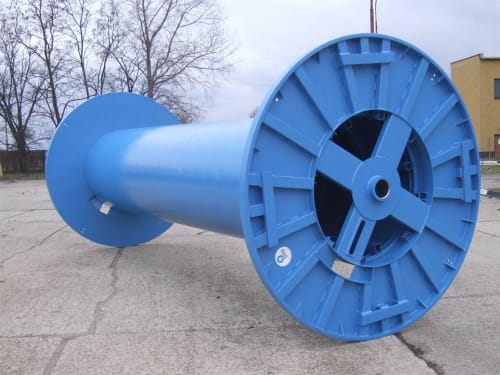
Structural drum for cables and ropes
Source: Image courtesy of GMP Slovakia s.r.o.
Reels, spools, drums, and bobbins
What they are and what are the main differences
What makes a reel a reel? And what makes it a spool, a drum, or a bobbin? There is no unequivocal answer to these questions. Sometimes they are interchangeable terms, sometimes not. They're all round, cylindrical objects around which you can wind things like wires, ropes, or cables. According to some sources, the term “reel” is especially used in British English, whereas “spool” is preferentially used by North American English speakers. Drums tend to be bigger, reels and spools smaller - but that's not always the case! As per “The WJI Book of Wire & Cable Terms”, “there is no universal agreement as to what makes a unit a reel instead of a spool, but it is generally understood that the larger sizes for any given product are reels while the smaller sizes are spools. (…) Reels and spools can also be called bobbins, which are generally understood to be small spools.” Mike McNulty, editor of the technical magazine “Wire & Cable Technology International”, found out that in the wire and cable industry these terms are commonly used for the same things without any regard to industry-wide specifications. According to him, the term “reel” is most appropriate. It is also mostly used in the following text as a collective term for objects which have the task of carrying continuously produced long and flexible goods such as wires, cables, monofilaments, fibers, threads, yarns, ropes, hoses, flexible tubes, bands, strips, tapes, and films.
Application areas
Reels are needed in the production of the above-mentioned products, for shipping and storage, as well as for downstream processing and their end-use. According to the respective application, reels are divided into process or machine reels, which are used in production lines, and shipping reels which are subdivided into single-use and re-usable reels, i.e. returnable and non-returnable.
The size of reels is expressed by the flange diameter, which can vary from some centimeters in the case of braiding bobbins to several meters in the case of cable drums, which are used for the installation of cables for underground or overhead power transmission lines. Considering the wide variety of applications, it is not surprising that there are hundreds of different reel styles and sizes available.
Certain reels are part of a manufacturing system and fulfill the functions of process and shipping reels. One example is the Niehoff Package System NPS, a handling system for automotive wires developed by the machinery factory of the same name.
The NPS – a spooling system
This system consists of special spoolers and matching collapsible multiway spools made of ABS or PP plastic. The spoolers are designed to operate in line with extrusion lines and wind the insulated wire coming from there with a particular conical wire laying technology onto these spools which offer a secure, stable, and tangle-free package both when full or partially empty and enable the highest cable pay-off speeds into downstream processes. Empty NPS spools can be fully dismantled and nested into each other. In this state, they require relatively little return shipping volume, and upon return to the cable manufacturer, they can be re-assembled and then re-used for dozens of cycles.
New NPS spools can be equipped with an RFID transponder system. Thanks to this system, users can identify if a spool belongs to the system and is compatible with it. As the spool identification is stored in the RFID chip, no label is needed.
Fixed reels
This group of reels is characterized by the fact that they are permanently assembled, as opposed to take-apart reels. Being part of lifting and hauling systems such as cranes, elevators, and ropeways, for example, these reels are used for winding and unwinding of steel wire ropes and power cables.
Reel design
All reels are composed of a cylindrical core, which is called barrel, and flanges at the ends to retain the material wound around the core. The core in many cases is hollow so that the reels can be placed on an axle for mechanically turning them. On a reel flange, there are holes or devices for inserting the ends of the wound material. Both ends are thus accessible. In the case of conductive material, final tests can be carried out.
Besides the flange diameter, important criteria for the description of a reel are the barrel diameter, the diameter of the axial hole, the reel width, and the traverse width.
Reels: choice of materials
Reels are usually made of plastic, steel, wood, plywood, or cardboard. Plastic reels are characterized by lightweight and durability and are used for lighter-weight cables such as automotive wires and a wide variety of other purposes. These reels can be manufactured as precision machine elements, as re-usable transport reels, or as one-way reels. Typical materials used for them are PS, ABS, PE, PP, and PA including recyclates. The components are manufactured by injection molding.
Precision-machined steel reels can be equipped with pressed flanges and are welded as fixed reels or designed as demountable reels. Steel reels are more durable than wooden reels and, depending on the size, can be loaded with a different range of products from the lightest wires to the heaviest cables. There are steel reel manufacturers who offer reels with a flange diameter of up to 10,000 mm and for loads of up to 500 t. Steel reels can be galvanized and in this way protected against corrosion.
Wood reels are characterized by lightweight and durability and can carry heavy loads. Wood, however, tends to absorb moisture and has to be impregnated before use. This makes recycling difficult.
Plywood reels are used for transporting lighter loads and are a cheaper alternative to other types of reels and are used above all in the building industry. Plywood reels are often only used once and then destroyed. Cardboard reels are used extensively in lightweight applications.
Demands on reels and selection criteria
Reels are manufactured according to industry standards or customer specifications. Desirable characteristics are high stability and impact resistance, optimal concentricity, and straight, smooth flanges. Conical flanges facilitate high pay-off speeds and easy gliding of the wound material. The pressure build-up on the inner surfaces of the flanges is better absorbed with this design than with a flange at right angles to the barrel.
Process reels are designed for permanent industrial applications and have to be built very robustly to bear heavy loads with high centrifugal and tensile forces. These reels must have high dimensional precision with a good concentricity and be dynamically balanced to allow winding at high speeds.
Shipping reels are designed as one-way reels or reusable reels. With shipping costs in mind, reusable reels can be designed to be dismantled and reassembled.
The selection of a reel depends on the application conditions and criteria such as diameter, bending radius, and load of the material to be wound as well as the capacity volume and the fill factor.
Literature:
Neal Rothwell: Technical information on the principles of spooling. Double R Controls Ltd., Heywood, July 2001.
www.drc.co.uk/DRC/TECH-DOCS/Docs/Spooling.pdf
